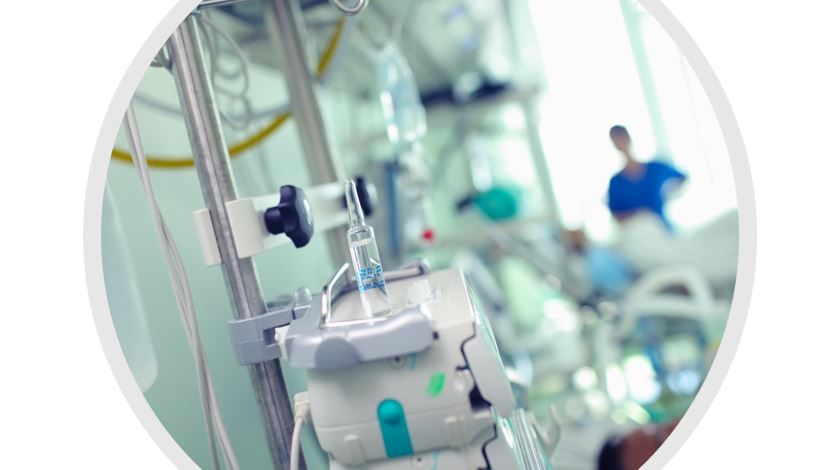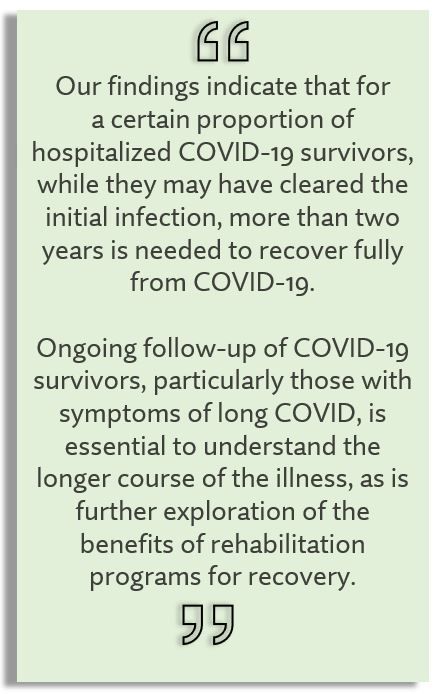Half of Hospitalized COVID-19 Survivors Report at Least 1 Enduring Symptom at 2 Years
The most common persistent symptoms reported at 2 years are fatigue, shortness of breath, and sleep difficulties. ©Sudok1/adobe stock

More than half of patients admitted to the hospital for COVID-19 infection, regardless of severity of illness, reported at least one persistent symptom at 2 years, according to findings published May 11, 2022, in the Lancet.
The most common lingering sequelae, according to investigators, are fatigue, shortness of breath, and sleep difficulties.
Although physical and mental health for these patients generally improved over the 2-year period, investigators found that hospital "survivors" continue to have poorer health and quality of life vs the general population.
Authors of the study, which followed nearly 1200 participants in China who were infected during the first months of the pandemic in 2020, believe it is the longest longitudinal follow-up to date of persons who have recovered from acute COVID-19.
Inconsistent information
Long-term effects of SARS-CoV-2 infection have been observed in a considerable proportion of individuals who have survived hospitalization and affect multiple organs and systems, write the researchers, led by Bin Cao, MD, of the China-Japan Friendship Hospital, Capital Medical University, in Beijing. But given the significant heterogeneity in previous studies and follow-up of just 1 year after acute infection, the true prevalence and overall health outcomes of the condition remain unclear.
Citing this knowledge gap as a risk to population health as SARS-CoV-2 continues to cause surges in infection throughout the world, Cao et al sought to characterize the long-term health outcomes in patients discharged from the hospital after COVID-19 infection over 2 years as well as specific health impacts of long COVID.
The researchers published 2-year follow-up data from an ambidirectional, longitudinal cohort study of 1,192 patients who survived COVID-19 and were discharged from Jin Yin-tan Hospital between January and May 2020.
Health outcomes of interest
Participants attended follow-up assessments at 6 months, 12 months, and 24 months after COVID-19 symptom onset during which investigators assessed health outcomes using measures including the 6-minute walking distance (6MWD) test, laboratory tests, and questionnaires about symptoms, mental health, health-related quality of life (HRQoL), return to work, and health care use after discharge. A control group was assembled of participants from the general population without COVID 19 who were age-, sex- and comorbidities-matched to participants in the survivor group to assess recovery status at 2 years.
The researchers defined the primary outcomes of interest as symptoms, scores on the modified British Medical Research Council (mMRC) dyspnea scale, HRQoL, 6MWD, and return to work and these were assessed in all COVID-19 survivors who attended the 3 follow-up visits. Symptoms, mMRC dyspnea scale, and HRQoL were also assessed in controls.
The research team reports that median age of the COVID-19 cohort was 57 years and 46% were women; median follow up time after symptom onset was 185 days, 349 days, and 685 days at the 6-month, 12-month and 24-month visits, respectively.
General positive trends
Symptoms. Cao and colleagues found that while the proportion of survivors with at least 1 reported symptom at 6 months was 68%, at 2 years that had decline to 55% (P<.001). The most frequently reported symptom throughout the 2-year follow-up, write the team, was fatigue or muscle weakness, present at the 6-month visit in more than half (52%) of survivors and with a decline to 39% at 2 years.
mMRC. Compared with 26% of patients with a mMRC score of at least 1 at 6 months, the researchers found the proportion significantly lower at 2 years, at 14% of patients with a score of at least 1 (P < .001).
HRQoL. Also exhibiting a more positive trend, according to the findings, was HRQoL in nearly all domains and particularly in anxiety and depression. While 23% of survivors reported symptoms of both mental health issues at 6 months, the proportion was nearly halved at 2 years, at 12% (P<.001). Investigators also observed a continual decline in the percentage of hospital survivors overall with 6MWD less than the lower limit of normal as well as in 3 prespecified subgroups with varying levels of initial disability.

Return to work. Cao et al report, too, that regardless of severity of initial illness, at 2 years 439 of 494 (89%) participants who were employed before the COVID-19 pandemic had returned to their jobs.
Long COVID survivors
After multivariable adjustment, researchers report, when they compared COVID-19 survivors without long-COVID to those with persistent symptoms, the latter had greater odds for mobility problems (OR = 3.81; 95% CI, 1.62-8.93), were more likely to have pain or discomfort (OR = 4.42; 95% CI, 3.14-6.21), and had greater odds for anxiety or depression (OR = 7.46; 95% CI, 4.12-13.52).
Moreover, participants with long COVID symptoms had a higher risk of an outpatient clinic visit (OR = 2.82 95% CI, 1.99–4.00) and rehospitalization (OR = 1.64, 95% CI, 1.12–2.41) after discharge.
In a press statement from The Lancet, lead author Cao said: “Our findings indicate that for a certain proportion of hospitalized COVID-19 survivors, while they may have cleared the initial infection, more than two years is needed to recover fully from COVID-19. Ongoing follow-up of COVID-19 survivors, particularly those with symptoms of long COVID, is essential to understand the longer course of the illness, as is further exploration of the benefits of rehabilitation programs for recovery.
"There is a clear need to provide continued support to a significant proportion of people who’ve had COVID-19, and to understand how vaccines, emerging treatments, and variants affect long-term health outcomes.”
In the conclusion of the published study the authors write: “We plan to conduct yearly follow-ups in this cohort. The value of rehabilitation programs in mitigating the effects of long COVID and in accelerating recovery requires further exploration.”
Reference: Huang L, Li X, Gu, X, et al. Health outcomes in people 2 years after surviving hospitalisation with COVID-19: a longitudinal cohort study. Lancet. Published online ahead of print on May 11, 2022.